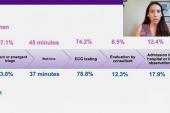Lancet Commission on CVD in Women Aims to Slash Global Burden
More than quoting statistics and pointing to gaps, the all-female commission set out 10 recommendations for meaningful change.

Understudied, underrecognized, underdiagnosed, and undertreated at a global level: cardiovascular disease in women is the focus of a new Lancet commission with the ambitious aim of reducing the worldwide burden of cardiovascular disease in women by one-third before 2030.
Presented as part of a plenary session at the American College of Cardiology (ACC) 2021 Scientific Session last night and simultaneously published in the Lancet, this initial report was compiled by an all-female writing group from 11 countries. Their somber message is that heart disease accounts for 35% of deaths in women but “stagnation” plagues efforts to reduce the impact of cardiovascular risk factors and heart disease in women.
According to lead commissioner Roxana Mehran, MD (Icahn School of Medicine at Mount Sinai, New York, NY), the initiative has been in the works for several years, and she credited the Lancet editors with first identifying the need to develop a commission focused on this topic.
As Lancet Senior Executive Editor Stuart Spencer, PhD, explained during the ACC plenary, the journal has developed well over 60 commissions over the years, originally devoted to topics like defeating AIDS, tackling air pollution, and creating healthier cities then shifted to more-focused clinical topics like dementia, eye health, asthma, and now cardiovascular disease in women. Commissions are “much more than reviews,” he elaborated, although a “fresh” and “extensive” review of the topic is “obviously . . . an essential starting point.”
He continued: “The idea of the commissions is to identify critical problems and provide a framework of research to resolve the issues to improve healthcare.”
For yesterday’s publication, with lead author Birgit Vogel, MD (Icahn School of Medicine at Mount Sinai), the commission drew on the most recent Global Burden of Disease Study results, produced by the Institute for Health Metrics and Evaluation, indicating that in 2019 there were an estimated 275.2 million cases of CVD in women worldwide. The distribution may be surprising: North Africa and the Middle East, high-income North America, eastern Europe, and central Asia had the highest age-standardized prevalence of cardiovascular disease, whereas all parts of Latin America, western Europe, and Australasia belonged to the regions with the lowest age-standardized CVD prevalence.
While the overall prevalence of CVD in women has declined by 4.3% since 1990, most notably in parts of Western Europe and several high-income Asian nations, some of the world’s most-populated countries, including India, China, and Indonesia, have seen rates inch higher. Understanding the different factors contributing to this patchwork is critical, Mehran stressed to TCTMD, particularly some of the underrecognized CVD risk factors such as unemployment, socioeconomic disparities, cultural status, as well as social and religious norms. A dedicated section of the report offers region-specific recommendations.
In 2019, the global age-standardized cardiovascular disease mortality rate in women was estimated at 204 deaths per 100,000, the report notes.
These sobering numbers should help galvanize action, said Mehran, no matter where clinicians are practicing or policy makers are focused. “When you see the number of deaths per year and you see that 35% of all deaths in women are due to cardiovascular disease, it really wakes you up, and I do believe that we need to make it central to government, to payers, to stakeholders setting metrics for physicians to care for women and make sure that we're educating, not just women, but everyone who is part of that care and begin intervening at all stages of life,” she said. “You cannot wait until a woman presents with cardiovascular disease in her late fifties to start intervening. . . . It's never too late, but it's also never too early.”
Concrete Recommendations
The report goes on to summarize the evidence and knowledge gaps in research, prevention, treatment, and access to care specific to women, and it provides 10 recommendations for data collection, research, and clinical care. Key takeaways have also been published as a downloadable infographic.
“There's not a single solution or key. . . . It's not just one box that you open and all the solutions are in there,” said Mehran. “You have approach this from multiple, different angles—social health, scientific evaluation, educational programs, as well as really prioritizing funding for a global health organization to help, with some of the work that they're doing, because most of that funding has been dwindling. I believe that we’re going to have a whole different view to global health after this pandemic, and I think this is the best times ever to begin to shed light on this important issue that we've been watching develop over the last four decades.”
Rather than producing a static, stand-alone document, the commission is also developing a website that will link stakeholders and track progress, Mehran explained, “hopefully mobilizing and igniting solutions—rather than just quoting statistics and showing gaps, actually doing something about some of the important arenas that need attention.”
The plan, she added, is to provide periodic updates every 3 to 5 years to evaluate what progress has been made, ahead of the full report in 2030.
Ultimately, the aim is to reduce the global burden of disease by one-third by 2030, which Mehran characterized as ambitious but “absolutely” achievable.
“I have no doubt in my mind, as we work through some of these top 10 recommendations and then some of the more detailed recommendations, that we will be able to really, really do it,” she stressed. “And I'll say this because look what we've been able to achieve with COVID-19. Where were we a year ago? And the only reason why we've been able to do this is by bringing all the stakeholders together focused towards the goal.”
An accompanying comment by Ana Olga Mocumbi, MD, PhD (Mozambique National Institute of Health, Maputo), also points to COVID-19, highlighting the stark global health disparities it exposed.
“In the midst of the COVID-19 pandemic, values of human dignity, solidarity, altruism, and social justice should guide our communities to ensure equitable share of wealth and leveraging of efforts towards the reduction of cardiovascular disease burden in women worldwide,” she writes. “The commission’s recommendations on additional funding for women’s cardiovascular health programs, prioritization of integrated care programs, including combined cardiac and obstetric care, and strengthening of the health systems accords with efforts to bridge the gap for the world’s worst off. Such a shift in women’s cardiovascular care would be a major step towards equity, social justice, and sustainable development.”
Note: Mehran is a faculty member of the Cardiovascular Research Foundation, the publisher of TCTMD.
Shelley Wood was the Editor-in-Chief of TCTMD and the Editorial Director at the Cardiovascular Research Foundation (CRF) from October 2015…
Read Full BioSources
Vogel B, Acevedo M, Appelman Y, et al. The Lancet women and cardiovascular disease Commission: reducing the global burden by 2030. Lancet. 2021;Epub ahead of print.
Mocumbi AO. Women's cardiovascular health: shifting towards equity and justice. Lancet. 2021;Epub ahead of print.
Disclosures
- Mehran reports grants from Abbott Laboratories, Abiomed, Applied Therapeutics, AstraZeneca, Bayer, Beth Israel Deaconess, Bristol-Myers Squibb, Cerecor, Chiesi, Concept Medical, CSL Behring, DSI, Medtronic, Novartis Pharmaceuticals, OrbusNeich, and Zoll; personal fees from Boston Scientific, Cine-Med Research, Janssen Scientific Affairs, Medscape/WebMD, American College of Cardiology, and American Medical Association; non-financial support from Regeneron Pharmaceuticals; consultancy or advisory board fees paid to her institution from Abbott Laboratories, Beth Israel Deaconess, Bristol Myers Squibb, Chiesi, Concept Medical, Daiichi Sankyo, Medtronic, Novartis, CardiaWave, Duke University, Idorsia, Spectranetics/Philips/ Volcano Corp; consultant fees paid to the institution of her spouse from Abiomed, Bayer; <1% equity in Applied Therapeutics, Elixir Medical, and STEL; and spouse’s <1% equity in ControlRad.





Comments